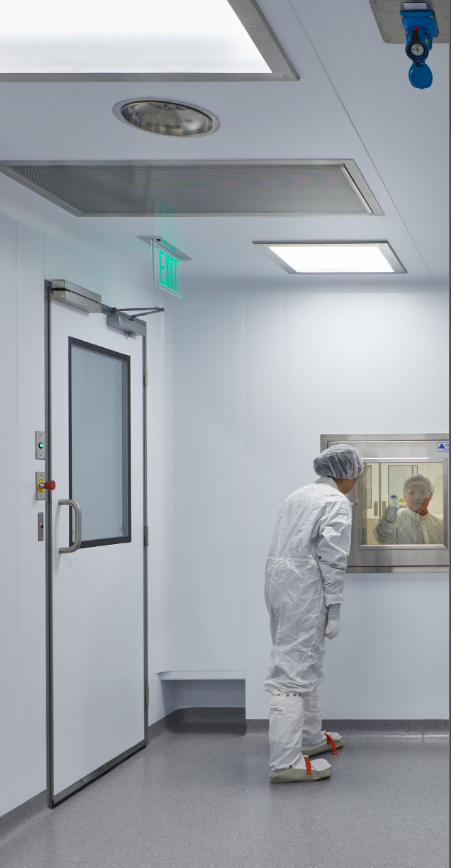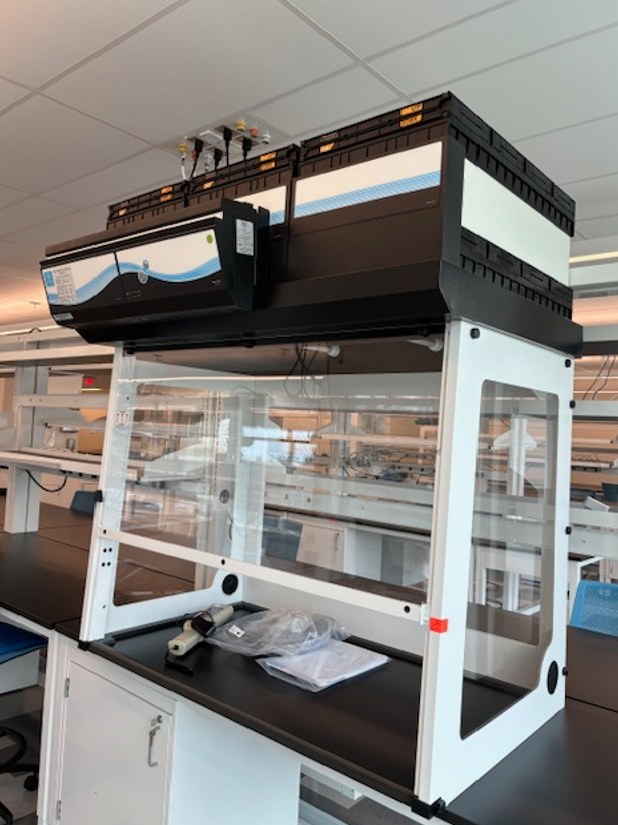Shaping a Sustainable Future for cGMP Facilities
Example of a modular cleanroom. Image: Perkins&Will
The biopharmaceutical industry, specifically cGMP facilities, consumes more energy and materials than other building types. However, it is imperative and possible to incorporate sustainable practices into cGMP facilities without compromising regulatory compliance, product quality, and patient safety.
We need to examine strategies that tackle the carbon footprint of our physical facilities at the outset of projects and then look beyond to address entire cGMP operations. These aren't standalone solutions, from process optimization to supply chain analysis to MEP systems; they're puzzle pieces. Adopting a holistic approach can usher in a paradigm shift towards environmentally responsible manufacturing practices.
Green chemistry and process optimization
Stringent regulations by the FDA, EMA, and other agencies restrict approved process changes for on-the-market drug products or substances. However, the research and development phases offer opportunities to embrace green chemistry. Solvent and reagent selection should be carefully considered due to their high-volume usage of often flammable or toxic compounds. Compared to more traditional chemicals, green chemicals minimize their environmental impact and enhance human health and safety. Ionic liquids, hydrogen peroxide, and organocatalysts are a few green chemistry alternatives that can limit or eliminate the need for hazardous materials.
Process optimization and lean manufacturing principles can reduce raw material consumption and improve operational efficiencies. Streamlining the purification and synthesis steps can help minimize waste, and establishing closed-loop, continuous-flow manufacturing processes can greatly reduce energy consumption. Operational energy usage can be further reduced by installing high-efficiency motors, integrating programmable automation, and monitoring sensors to identify and correct inefficiencies.
Supply chain analysis
The supply chain plays a crucial role in the overall lifecycle analysis of materials and is key to maintaining a circular economy. Transportation accounts for a large part of a product's carbon footprint, so local material sourcing should be prioritized. Instead of relying on large manufacturing and distribution centers, smaller regional centers can cut transportation costs and carbon impacts.
Leveraging digital technologies can also advance efficient and sustainable supply chain management and material handling. Robotics for material handling can reduce manual labor, leading to enhanced energy efficiency, reduced waste, resource optimization, and improved operational efficiencies.
Environmental Product Declarations (EPDs) that outline products' environmental impact are pushing the industry in the right direction. We can incentivize environmental transparency and make it the industry norm by prioritizing and promoting suppliers that publish EPDs, source their raw materials responsibly, and use sustainable packaging.
At first glance, single-use components may not appear to be a sustainable strategy; however, there are instances where they could be more sustainable than stainless steel equipment. Using single-use components saves water and energy for cleaning and sterilization. The carbon impact of single-use products can be mitigated by effectively recycling and using biodegradable materials. Additionally, a recent push towards the standardization of equipment parts has helped mitigate supply chain interruptions that result from unforeseen economic circumstances. With more standardization, we could reduce the precautionary overstock of warehouse inventories and the subsequent wasteful discarding of parts and materials due to expiration dates.
Build less, reuse more
The most sustainable building is the one that already exists. Before deciding to tear down an existing structure, consider renovating or expanding. Adaptive reuse typically results in lower environmental impacts than constructing a brand-new facility. When new construction is necessary, mass timber structural systems combined with low-carbon concrete can provide a flexible and innovative solution to traditional concrete and steel framing.
Floor plan diagram of an efficient cleanroom. Image: Perkins&Will
Beyond the building's structure, reusing existing equipment and limiting excess quantities can further reduce a facility's environmental impacts. Strategically locating equipment to be shared amongst user groups can reduce the number of fume hoods or biological safety cabinets (BSCs) within a space. cGMP facilities are often fit-out with redundant features, systems, and utilities to limit shutdowns associated with potential future space changes. However, these excess features incur a higher initial capital cost and are often never fully utilized. A more sustainable approach is to provide a lean base set of flexible features for future unknowns. Beyond the initial cost-saving benefits, this approach results in a more nimble space and is easier to adapt as scientific needs and technologies advance.
Explore efficient and modular design
Design inefficiencies and space underuse often arise from cGMP facilities' need for unidirectional, single-loaded supply and return corridors and separate airlocks for personnel, materials, and waste. Care must be taken to design an efficient, well-organized layout, which may include strategies for combining personnel and material airlocks between a suite and a return corridor and incorporating waste pass-throughs.
Example of a modular cleanroom. Image: Perkins&Will
Modular cleanroom panels can be a viable alternative to traditional stick-built construction, resulting in minimized material use and space footprint. These panels are increasingly constructed of recycled materials and have a narrower profile than traditional metal studs and drywall assemblies.
Sustainable MEP strategies
While mechanical systems account for a large portion of cGMP facilities' operational energy usage, their loads can be reduced by smart system assessment, right-sized energy-efficient equipment, and a well-insulated, efficient building envelope.
A typical lab may require between six to 10 air changes per hour; cGMP facilities can require up to 60 air changes per hour for Grade B rooms and sometimes more, depending on specific user requirements. Strategic risk assessments, efficient HVAC design, and continuous monitoring of particle counts and air quality should be leveraged to determine whether air changes can be reduced while maintaining product and personnel safety. Where appropriate, HEPA fan filter units that continuously reuse and recirculate air can significantly reduce the need to filter constantly and condition outside air. Additionally, well-sealed and insulated pipes, ducts, and valves prevent air leakage and minimize heat loss.
To reduce energy costs and improve indoor air quality, consider using economizers, heat pump recovery systems, and air-to-air recovery ventilators to capture and reuse otherwise wasted heat or cooling from various processes. The recovered energy can be used for space heating, water heating, or to drive absorption chillers for cooling. Specifying electrically powered equipment and carefully designed variable air volume (VAV) systems are further mechanical strategies that can provide lower energy alternatives.
Ductless fume hood. Image: Perkins&Will
Right-sizing energy-efficient equipment based on data-driven design loads can balance the risk of under-sizing equipment with the inefficiency of oversizing. Decarbonization through electrification of select equipment, such as all-electric autoclaves and glasswashers, can reduce the demand for utility systems.
When dealing with lower levels of hazardous materials and pending a risk assessment, Type C BSCs are a sustainable alternative to ducted fume hoods because they require less energy for the same function. Alternatively, ductless fume hoods provide an attractive alternative to traditional ducted ones and can significantly reduce the burden on the house's HVAC system. They can allow for reduced floor-to-floor heights by limiting the ductwork required in the interstitial space above the ceiling, leading to smaller equipment sizes and a reduction in initial capital expenditure.
We as an industry have made strides towards building and maintaining more sustainable buildings; however, more can be done by taking a holistic approach. We must strive for continuous improvement at every design, construction, science, and operation stage to ensure a sustainable future. cGMP facilities and their processes can be made more sustainable without sacrificing product quality and patient safety.




